
|
Astronomy Picture Of the Day (APOD)
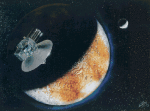 Pluto Not Yet Explored
Pluto Not Yet Explored
11.02.1996
Cold, distant, Pluto is the only planet in our Solar System which has not been visited by a spacecraft from Earth. The story goes that the legend "Pluto Not Yet Explored" on a US postal stamp depicting the tiny, mysterious world inspired a JPL employee to develop plans for a Pluto flyby.
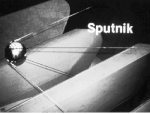 Sputnik: The Traveling Companion
Sputnik: The Traveling Companion
10.02.1996
Sputnik means "traveling companion". In stark contrast to this innocent sounding name, the launch of the Earth's first "artificial moon", Sputnik 1, by the Soviets on October 4, 1957 shocked the free world, setting in motion events which resulted in the creation of NASA and the race to the Moon.
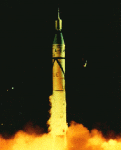 The First Explorer
The First Explorer
9.02.1996
The first US spacecraft was Explorer 1. The cylindrical 30 pound satellite was launched (above) as the fourth stage of a Jupiter-C rocket (a modified US Army Redstone ballistic missile) and achieved orbit on January 31, 1958.
 The Eye of an Hourglass Nebula
The Eye of an Hourglass Nebula
8.02.1996
What's happening in the eye-like center of this planetary nebula? The geometry revealed in this Hubble Space Telescope view of the central part of an "etched hourglass nebula" known as MyCn 18 presents a puzzle. First, the axis of this central region does not line up well with the outer hourglass structure.
 Hyakutake: The Great Comet of 1996?
Hyakutake: The Great Comet of 1996?
7.02.1996
Get ready for one of the most impressive but least anticipated light shows in modern astronomical history. Next month, newly discovered Comet Hyakutake will pass closer to the Earth than any recent comet. Unknown...
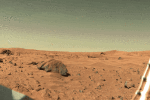 If You Could Stand on Mars
If You Could Stand on Mars
6.02.1996
If you could stand on Mars - what would you see? Viking 1 robot landers answered this question in 1976 with pictures like the one shown above. The dark rocks, red soil, and green-tinged sky grace this rendition of a normal Martian afternoon. At the bottom corners of the picture are portions of Viking spacecraft.
 COBE Hotspots: The Oldest Structures Known
COBE Hotspots: The Oldest Structures Known
5.02.1996
Above are two microwave images of the sky, looking north and south of our galaxy's equator, based on data from NASA's COBE satellite. After computer processing to remove contributions from nearby objects and the effects of the earth's motion, they show "spots".
 COBE Dipole: Speeding Through the Universe
COBE Dipole: Speeding Through the Universe
4.02.1996
Our Earth is not at rest. The Earth moves around the Sun. The Sun orbits the center of the Milky Way Galaxy. The Milky Way Galaxy orbits in the Local Group. The Local Group falls toward the Virgo Cluster of Galaxies.
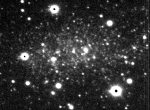 The Closest Galaxy: The Sagittarius Dwarf
The Closest Galaxy: The Sagittarius Dwarf
3.02.1996
What's the closest galaxy to our Milky Way? For many years astronomers thought it was the Large Magellanic Cloud (LMC). But the seemingly insignificant fuzzy patch shown above turned out to be part of a galaxy that is even closer.
 A Huge Impact Crater on Mars
A Huge Impact Crater on Mars
2.02.1996
What hit Mars? The impact crater Schiparelli near the center of the above image was likely caused by a collision with an object the size of an asteroid. Also evident in this full face mosaic of Mars are numerous craters from many other impacts with smaller objects over billions of years.
|
January February March April May June July August September October November December |
|||||||||||||||||||||||||||||||||||||||||||||||||